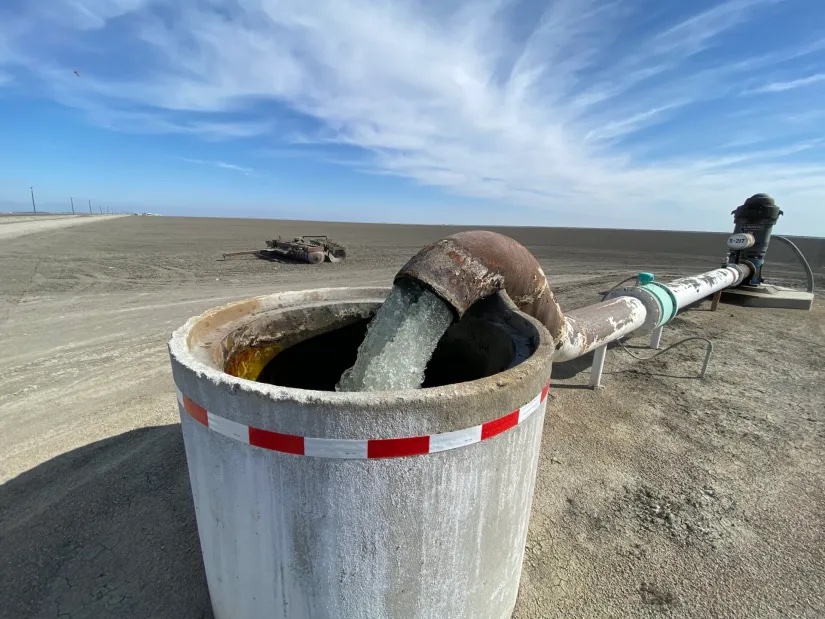New wells for agriculture will be more difficult to drill in the San Joaquin Valley under Gov. Gavin Newsom’s recent executive order in response to the ongoing drought.
Part of the order prohibits new wells from being drilled without approval from local groundwater sustainability agencies (GSA) first. The GSAs must determine that new wells or changes to existing wells won’t hurt their groundwater sustainability goals, damage infrastructure or cause ground subsidence.
“It’s a historic move that we’re really proud to see happening,” said Kyle Jones, policy and legal director for nonprofit Community Water Center.
Most emergency drought actions from governors in the past have focused on urban water conservation, said Jones.
Before this executive order, wells were permitted by county staff. Most counties only required some paperwork and easily approved wells, said Jones.
There is a “critical gap” in the way it’s been done at the county level, said Uriel Saldivar, senior policy advocate for Community Water Center at a press briefing on water in the San Joaquin Valley.
“They don’t take a look at consideration for drinking water impacts,” said Saldivar.
The executive order is meant to change that and accompanies the Sustainable Groundwater Management Act (SGMA), the state law which aims to bring aquifers back into balance by 2040, meaning generally that more water isn’t pumped out than goes back in.
Farmers have pumped water out of the ground in the valley without limits for generations. In drought years, they rely more heavily on groundwater. That has caused groundwater levels to plummet in recent years causing a range of problems such as sinking ground, dry domestic and community wells, contaminated drinking water and damaged infrastructure.
The new permitting process applies to all groundwater subbasins classified as medium or high priority. That includes the entire San Joaquin Valley.
There are about 2 million wells in California and anywhere from 7,000 to 15,000 new wells built every year, according to the state Department of Water Resources. Tens of thousands of residents in the valley rely on domestic wells for water. And 87% of the valley’s population is served by 50 water utilities which mostly pump groundwater.
Many GSA staff members don’t know exactly how the new permitting process will work yet.
“We were, I think all taken by surprise on this,” said Eric Osterling, general manager of the Greater Kaweah GSA in Tulare and Kings counties. “We have a lot of things that are burning on a short fuse and having to pivot in order to address one more thing is difficult, so it is concerning.”
Osterling said the new process may require new onboarding, software and staff training and could also bring new legal risks to the GSA. GSA staff is planning to meet with county staff to hammer out the details of how the process will work.
This all comes as valley GSAs are in the process of changes to their groundwater plan, most of which were deemed incomplete by the state Department of Water Resources back in January. That designation started the clock ticking, giving GSA staff six months, or until July, to make changes and resubmit plans for a second look.
Greater Kaweah GSA is also in the middle of a 90-day public comment period on its plan’s rules and regulations. Staff is preparing to implement groundwater pumping limitations, said Osterling.
He said he and his staff haven’t discussed the logistics of adhering to the well portion of the drought executive order with the governor’s office.
He said Kaweah’s sustainability objectives have never focused on the number of wells but rather how much wells are pumping and where.
While the executive order is temporary and lasts only as long as the drought, Assembly Bill 2201 introduced by Assemblymember Steve Bennett (D-Ventura) seeks to make the permitting process permanent. The bill is set for its first hearing on April 26.
It isn’t clear how the new process will be enforced on the ground. But advocates say once the process is ironed out, it will help to reach sustainability.
“This will certainly be helpful. We’re not seeing a slowdown in well drilling,” said Community Water Center’s Jones. “This is sending the signal that we’re not going to let folks continue to just shift to groundwater use in a way that’s really going to prevent SGMA from being implemented.”
Share this:
- Click to share on Facebook (Opens in new window)
- Click to share on Twitter (Opens in new window)
- Click to share on LinkedIn (Opens in new window)
- Click to share on Reddit (Opens in new window)
- Click to share on Tumblr (Opens in new window)
- Click to share on Pinterest (Opens in new window)
- Click to share on Pocket (Opens in new window)
- Click to share on Telegram (Opens in new window)
- Click to share on WhatsApp (Opens in new window)
- Click to print (Opens in new window)








